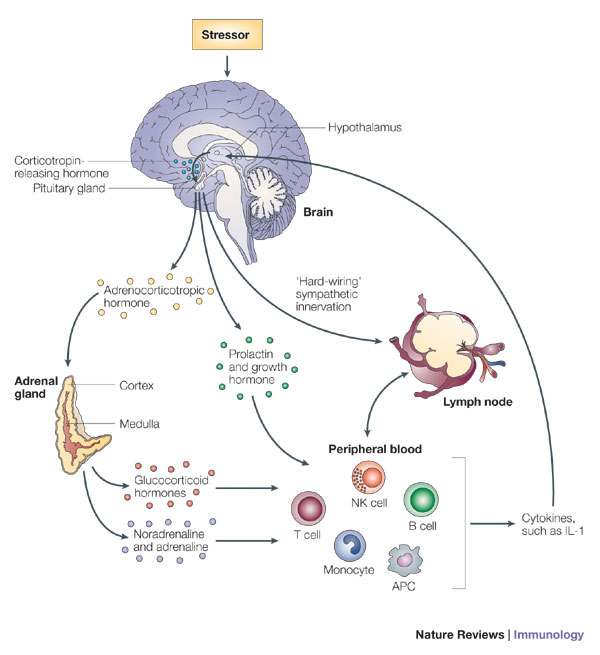Multiple Organ Failure as an NeuroEndocrine-Mediated Response to Chronic Stress
Homeostasis is the coordinated system of physiological and biochemical processes which regulate and maintain most of the steady states in the organism, attempting to keep the internal conditions relatively constant, for example: pH, internal temperature, etc; in a state of equilibrium. This concept is essential to the understanding of stress.
In everyday life, there are numerous factors that recurrently disrupt homeostasis, such as, environmental factors or internal and external stimuli. This coordinated system then works to keep the organism in an incessant flux around particular variables that could be considered optimal conditions for it to live and survive. Any deviation relatively far from the optimal equilibrium and the organism’s specific response, involving a number of processes which strive to restore normal body conditions, can be perceived as Stress.
As per the particular event, response to stress is by Sympathetic nervous system (SNS) activation which leads to the so-called Fight-or-Flight response, or Cannon’s reaction. This state cannot be maintained for extended periods of time as it could be detrimental to the physical and mental health of the organism. The Parasympathetic nervous system (PNS) seeks to returns the conditions to the more optimal range. This restoration consumes a lot of energy and resources, putting a lot of strain on the body, but seeks to focus it to repress the immediate problem. One such process to overcome chronic stress is multiple organ failure caused by the organism's own system.
Contents
Stress Response
|
HypothalamoPituatary Adrenal Axis
The HypothalamoPituataryAdrenal (HPA) axis, is an intricate set of interactions among three endocrine glands, being the hypothalamus, pituitary gland, and adrenal glands. These interactions constitute a major part of the neuroendocrine system responsible for the response to stress, as well numerous body processes that affect the organism both physically and mentally. These include regulation of energy stores and energy expenditure, sexuality, digestion, the immune system as well as emotions.
Fundamentally, the HPA axis responds to stressors through the release of cortisol in a long term, delayed process. The Hypothalamus secretes Corticotropin Releasing Hormone (CRH) and Vasopressin (ADH) into the portal circulation of the pituitary gland by neurons of the Paraventricular nucleus (PVN). These elicit the release of Pro-Opiomelanocortin polypeptide (POMC) from the Adenohypophysis, which can then be cleaved into several hormones. This includes Adrenocotricotropic hormone (ACTH), . ACTH, through systemic circulation, arrives at the cortex of the Adrenal gland and stimulates the release of Cortisol. CRH itself, also takes part in the physio- and psychological response to stressors (Del Giudice et al., 2011).
General Adaptation Syndrome
General Adaptation Syndrome (GAS) outlines an organism’s stress response. It is mediated by the interactions of the HPA axis, and can be distinguished into four phases (Taylor et al., 2012):
Initial phase
The primary factor in the development of stress is the immediate release of ACTH. It acts on the adrenal glands and stimulates the secretion of catecholamines i.e., Epinephrine, Norepinephrine, and Dopamine, which in turn cause an increase in blood pressure, and heart and respiratory rates. This can be referred to as Cannon's alarm response, or theFight-or-Flight theory, and is under the influence of the Sympathetic nervous system (Taylor et al., 2012)
Phase of Resistance
Catecholamine levels decline, however, ACTH levels remain high resulting in the production of Glucocorticoids by the adrenal cortex, which play an important role in providing the optimal conditions for the body's ability to resist stress. They also ensure that relatively less important processes, not required for immediate survival, such as functioning of the digestive tract, energy storing processes, immune system and insulin secretion,even though hyperglycemia occurs due to excessive gluconeogenesis. Fat oxidation becomes the main energy source. Carbohydrate synthesis is made possible by the utilisation of amino acids that are released during the breakdown of muscle. Due to these factors, the organism is able to withstand the effects of stress for a long time, however, over exposure to these factors over a prolonged perioid could result in one of the following two phases (Taylor et al., 2012).
Phase of Exhaustion
Persistence of stress would result in depletion of available energy reserves, which would lead to collapse and, in due course, death of the animal (Taylor et al., 2012).
Phase of Adaptive Disorders
Adaptive disorders aim to redirect the body's energy and focus, at the expense of another organ's supply and functioning, to systems that would allow it to combat the stress. For example arthritis, chronic hypertension, ulcers or multiple organ failure (Singer et al., 2004; Taylor et al. 2012).
Autonomic Nervous System
Multiple Organ Failure
Sepsis and other critical illnesses lead to a biphasic inflammatory, immune, hormonal, and metabolic response. A pronounced increase in the secretion of the stress hormones with an associated increase in mitochondrial and metabolic activity, marks the acute phase. As a result of the changes in the endocrine profile and intense inflammation, energy production, metabolic rate, and normal cellular processes decrease drastically, thereby resulting in Multiple Organ Dysfunction or failure (Singer et al., 2004; Taylor et al. 2012).
Benefits of Future Research
blah
References
Taylor, Shelley, and Sirois, Fuschia. (2012). Health Psychology 2nd Canadian Edition

